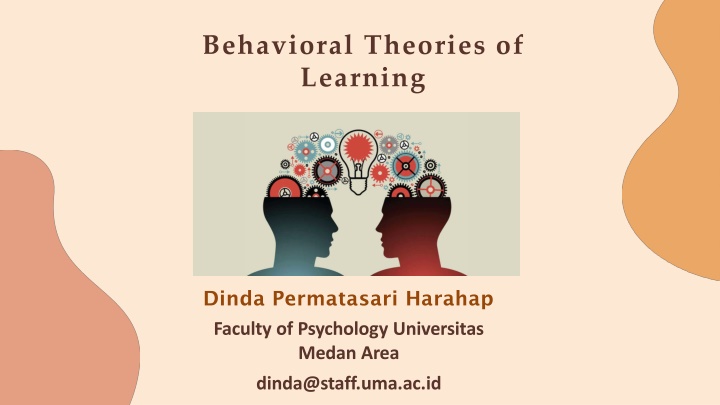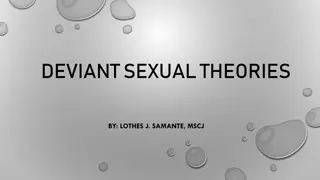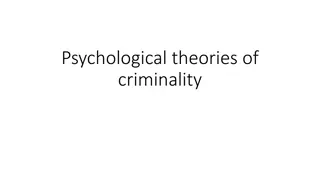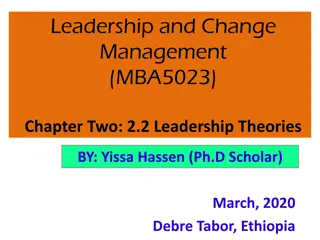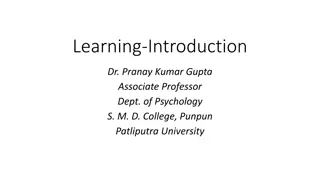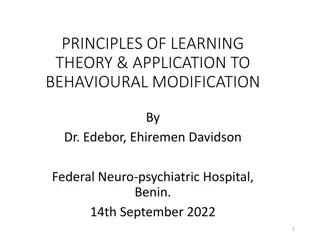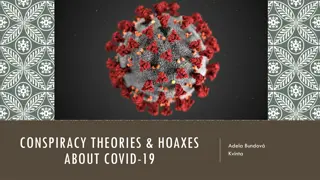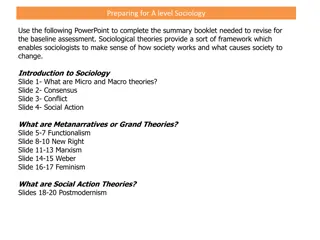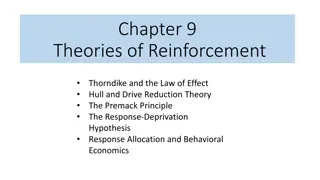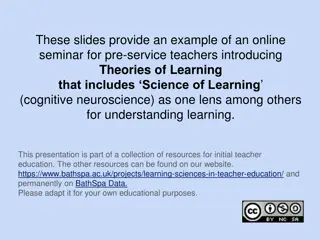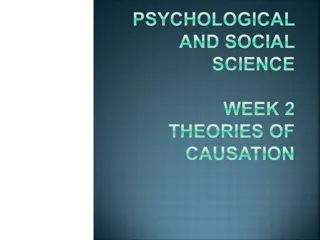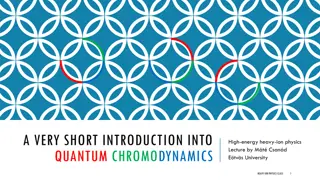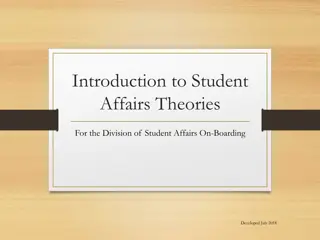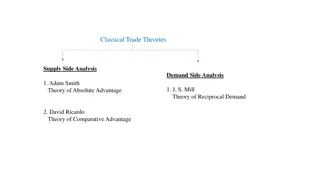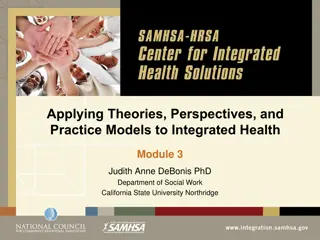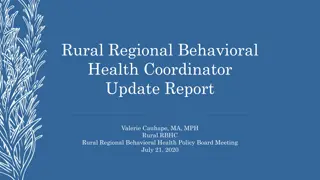Behavioral Learning Theories and Principles
Dive into the world of behavioral learning theories and principles. Explore classical conditioning by Pavlov, Thorndike's Law of Effect, and Skinner's Operant Conditioning. Understand how behaviors are shaped by consequences and antecedents in the learning process.
Download Presentation

Please find below an Image/Link to download the presentation.
The content on the website is provided AS IS for your information and personal use only. It may not be sold, licensed, or shared on other websites without obtaining consent from the author.If you encounter any issues during the download, it is possible that the publisher has removed the file from their server.
You are allowed to download the files provided on this website for personal or commercial use, subject to the condition that they are used lawfully. All files are the property of their respective owners.
The content on the website is provided AS IS for your information and personal use only. It may not be sold, licensed, or shared on other websites without obtaining consent from the author.
E N D
Presentation Transcript
Behavioral Theories of Learning Dinda Permatasari Harahap Faculty of Psychology Universitas Medan Area dinda@staff.uma.ac.id
Learning Materials What s Learning? What Behavioral Learning Theories Have Evolved? What Are Some Priciples of Behavioral Learning How was Social Learning Theory Contributed to Our Understanding of Human Learning?
Learning Learning Learning is usually defined as a change in an individual caused by experience
What Behavioral Learning Theories Have Evolved? Pavlov : Classical Conditioning Thorndike : The Law of Effect Skinner : Operant Conditioning
In classical conditioning, a neutral stimulus (such as a bell) that at first prompts no response becomes paired with an unconditioned stimulus (such as meat) and gains the power of that stimulus to cause a response (such as salivation).
Behaviors followed by favorable consequences become more likely, and behaviors followed by unfavorable consequences become less likely
An individual makes an association between a particular behaviour and a consequence
What Are Some Principles of Behavioral Learning? The Role of Consequences Reinforcers Intrinsic and Extrinsic Reinforcers Punishers Immediacy of Consequences Shaping Extinction Schedules of Reinforcement Maintenance The Role of Antececents
The Role of Consequences Consequences strengthen behavior; unpleasant consequences weaken it Consequences are called reinforcers; unpleasant consequences are called punishers The most important principle of behavioral learning theories is that behavior changes according to its immedate consequences
Reinforcers Any consequences that strenghthens (increases the frequency of) a behavior The effectiveness of the reinforce must be demonstrate Consequences are called reinforcers; unpleasant consequences are called
Primary and Secondary Reinforcers Satisfy basic human needs. Some examples are food, water, security, warmth, and sex Primary Reinforcers that acquire their value by being associated with primary reinforcers or other well-established secondary reinforcers Secondary
Positive and Negative Reinforcers Reinforcers that are used in schools are things given to students. Ex : praise, grades, and stars Positive Reinforcers that are escapes from unpleasant situations Negative
The Premack Principle Sometimes called "Grandma's Rule" from the age-old statement "Eat your vegetables, and then you may play." As soon as you finish your work, you may go outside
Intrinsic and Extrinsic Reinforcers Behaviors that a person enjoys engaging in for their own sake, without any other reward. Intrinsic Praise or rewards given to motivate people to engage in behavior that they might not engage in without thein. Extrinsic
PUNISHER Unpleasant consequences used to weaken behavior..
PUNISHER An aversive stimulus following a behavior, to decrease the chances that the behavior will occur again. Presentation Punishment An unpleasant consequence that a person tries to avoid or escape. Aversive Stimulus
PUNISHER Withdrawal of a pleasant consequence that is reinforcing a behavior, designed to decrease the chances that the behavior will recur. Removal Punishment Procedure of removing a student fiom a situation in which misbehavior was being reinforced. Time Out
Immediacy of Consequences it makes clear the connection between behavior and consequence PURPOSES it increases the informational value of the feedback
Shaping The teaching of a new skIll or behavior by means of reinforcement for small steps toward . Extintion The weakening and eventual elimination of a learned behavior as reinforcement is withdrawn.
How was Social Learning Theory Contributed to Our Understanding of Human Learning? Bandura-Modeling and Observational Learning Meichenbaums Model of Self Regulated Learning Strenghts and Limitations of Behavioral Theories
Bandura Modeling & Observational Learning Attention Retention Observational Learning Reproduction Motivation
Meichenbaums Model of Self Regulated Learning
Strenghts and Limitations of Behavioral Learning Theories LET S DISCUSS
